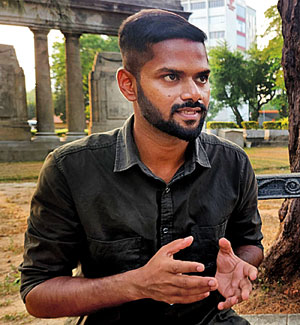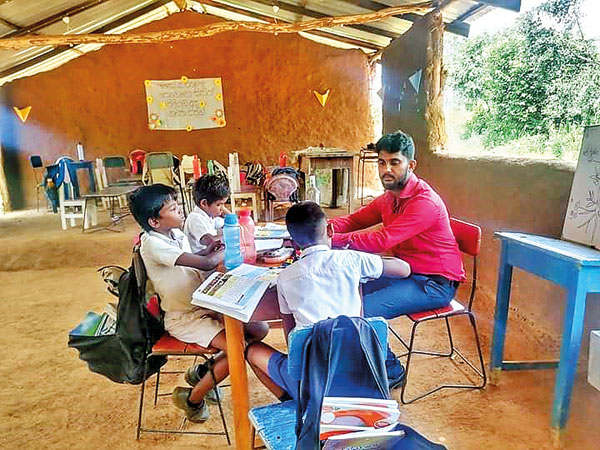News
Govt.’s new education policy: Critics hit out at lack of equity, defenders say move towards modernity
View(s):By Mimi Alphonsus
Dramatic overhaul recommendations in the government’s New Education Policy Framework (NEPF) have caused serious concerns, with even some of its drafters agreeing that its most contentious points must be revisited before implementation.
Its creators maintain that the 33-page NEPF was essential to adapting public education to modern student needs and insist the reforms will enhance skills and improve employability. But critics are calling it the “nail in the coffin of free education,” warning that it will widen inequality and only serve the interests of private corporations.

Madushan Chandrajith
The NEPF was drafted last year on the Presidential Secretariat’s initiative under the supervision of a Cabinet committee. It was assisted by a 25-member expert group. Many of the recommendations were approved by the Cabinet committee, while the rest are under fresh review.
Lack of clarity in key recommendations
A key NEPF recommendation is to transform the administrative and financial management of school education.
School “clusters” will be created, comprising a lead school and five to seven smaller ones. They will be empowered to manage and share resources with each other. Funding will be on a “per-student basis, with the per-student rate adjusted according to the state of existing facilities and the performance of the school.” There will be special provisions for disadvantaged schools.
This is a dramatic shift from the current model, where the government pays for salaries and the provinces distribute funding for remaining school expenses. NEPF drafters explained that the proposal was aimed at fixing the gross inefficiencies and lack of accountability in how funding is allocated and used.
But critics raised alarm. Joseph Stalin, General Secretary of the Ceylon Teachers Union, cautioned that schools with fewer than 100 students will be badly hit by a per-student funding scheme and that the NEPF shows “zero concern” for mostly rural, mostly poor, students.
They contend that schools of any size require a minimum amount of funding to be able to teach a reasonable variety of subjects and to have basic facilities. Small schools have fewer students per subject teacher than denser schools. If funding is allocated on a per-student basis, the money could be insufficient to cover the salaries of the number of teachers required to teach multiple subjects. (According to the Department of Census, nearly 3,000 schools have less than 100 students.).
A former Education Ministry Secretary, Tara De Mel, who has worked in government education policy for over a decade, also warned that performance-based funding “can be grossly unfair to students” because the only current metric is examinations.
Poorer schools generally do worse in examinations (or any assessment) owing to factors like bad nutrition, lower-quality teaching and facilities, less wealthy and educated parents, and a high propensity to miss school or drop out. If schools are granted funding based partly on how well they perform, the poor ones risk losing much-needed support.
Sujata Gamage, a researcher at LIRNEAsia was one of the NEPF drafters. She acknowledged that there were issues with performance-based funding and that there was a need for clarity. She emphasised that the policy would be revised to replace this model with different accountability measures.
Student debt

Schools with little facilities and a few students will be further hit by the NEPF
Another recommendation causing heated debate is on the financing of state universities. The NEPF introduces “student contributions” in addition to government and other sources of funding. And “student contributions” are defined as “government grants, government-backed loans, and out-of-pocket contributions” whilst “the distribution of each and the related formulae, including criteria for merit and ability to pay, [is] to be determined”.
The language suggests a departure from free university education. Sources involved in the drafting, who requested anonymity, were reluctant to confirm that state universities will no longer be free to all. And they urged that this recommendation be postponed until expert modelling was done.
“Due to a powerful university lobby, the government spends more money on the minority of students who go to university than they do on school students,” argued Dr. Gamage. “It’s very important that we shift our focus.” Universities must be competitive and find funding without relying exclusively on the state. This allows for more money to be reserved for general education, she said.
Inter-University Students Federation convenor Madushan Chandrajith accused the state of “completely abrogating its responsibility to students”. The IUSF has begun protesting against the NEPF. The Ceylon Teachers Union and the Federation of University Teachers Association have also said they oppose it.
The new funding system would see government grants becoming enrolment- and performance-based, meaning that universities will be expected to compete with one another for students and funds by showcasing the employability of their graduates. Additionally, recipients of government grants will have the option of redeeming them at either public or private universities.
According to the University Grants Commission (UGC), as of 2019, just 51% of enrolment in state universities is in medium- to high-employability fields such as engineering or computer science. This suggests problems with the allocation of spots in universities. The new funding scheme wants to resolve this by pushing for competitiveness among universities, with employability of graduates as the criterion.
Is the problem at school level?
But the National Education Commission states that the trend against employable fields is the same in private universities and in public ones—suggesting that the root may be in the secondary education sector rather than university competitiveness. The 2020 annual school census shows that over 65 percent of all schools that have A/Level streams offer only arts and commerce subjects, automatically disqualifying their students from more employable fields.
“The problem lies at the school level,” said Shamala Kumar, Senior Lecturer at the University of Peradeniya and a member of the Kuppi Collective of Academics. “Many students come in with little English and are expected to succeed in an English-medium degree programme. Universities must have the capacity to support them, but unfortunately we don’t.” She feels the government started implementing the “spirit” of the NEPF even before its creation through funding cuts that crippled universities.
“Universities are relying more and more on earned income from fee-levying courses, privately funded research, and foreign students,” she said. “But while Colombo can manage this, what happens to less central universities, like Uva-Wellassa and Jaffna?”
Practical considerations
Other notable recommendations include introducing English medium to all schools and students; teaching artificial intelligence (AI) and climate change; replacing the UGC with the National Higher Education Commission and expanding its purview to private universities; introducing school completion certificates in grades 11 and 12; and issuing legally mandated timeframes for national examinations.
Some critics claimed, however, that many of these were impractical and did not address problems at their root. For instance, plans to introduce AI to schools, Dr. de Mel said, were laudable—but “without facilities such as digital labs and internet connectivity, and without a significant increase in trained teachers, these policies cannot be implemented successfully.”
Census data shows that, as of 2017, just 55 percent of schools had any computer facilities available to students.
There are similar issues with English-medium with the country unable to find enough English-language teachers, let alone English-medium teachers. The President has ordered 2,500 English teachers to be recruited, amidst a sector-wide hiring freeze. The goal is to raise the number of English-medium schools from 765 to 1,000 by next year.
The Sunday Times learned, however, that even existing English-medium school have a shortage of over 2,700 English-medium teachers. And sources who contributed to the NEPF confessed that the policy would have to be scaled down due to budgetary constraints.
Arjuna Parakrama, Professor Emeritus, Peradeniya University, is affiliated with the Sectoral Oversight Committee on Education. He is a vociferous critic of the NEPF, saying a major problem is that it does not address any of the problems faced by most students today.
“There are schools without proper bathrooms, where children are fainting because they haven’t had a meal,” he said. “Even at university, students go home for the weekend because they can’t afford the food at the canteen and we have a major shortage of teachers. But there is no mention of equity.”
“They have basically said they want to improve the quality of 1/4th of the schools, and the rest can go to hell,” he concluded. “This will change the country forever.”
The Process
The NEPF drafting process is also a point of contention. The new policy supersedes an existing 417-page framework drafted by the National Education Commission, which has been legislated to handle education policy. Dissatisfied with the NEC’s outcomes, President Ranil Wickremesinghe set up the NEPF.
Civil society, trade unions and education officials say they felt left out and replaced with industry professionals, pointing to the composition of the 25-member expert committee as evidence. The group comprises, amongst others, four government officials, two current and former members of the UGC, three state university academics, eight IT professionals, other industry professionals, representatives from the World Bank (WB) and Asian Development Bank (ADB), and one school principal.
Drafters wanted input from the public and private education sectors to formulate creative solutions to make graduates more employable. But critics claim the committee lacks knowledge on challenges in education and that there are conflicts of interest.
After the drafting, teachers, principals, the GamaniCorea Foundation and the Bandaranaike Academy for Leadership and Public Policy were consulted. But teacher unions, faculty unions, and student unions were not.
The NEPF is now open for public feedback and has attracted 216 submissions so far.
Implementation
One source involved in the NEPF said it was “just a framework” and that clear details and an implementation plan would have to be provided in subsequent documents. Many of the recommendations will also have to be legislated and passed in Parliament where they can be challenged. Prof. Parakrama fears, however, that changes will be forced through circulars without public consent.
Meanwhile, the President has started acting on some proposals. On March 12, Tuesday, he called on the Cabinet Committee to implement the NEPF. He has ordered that legislation to create a National Teachers’ Council (as recommended) be drafted and presented to parliament within a month. And an Oversight Committee was set up to implement the NEPF.
Still, there is a question of funding for implementation. The NEPF does not call for increased government funding for education, but there are reportedly other sources in the pipeline.
Anura Dissanayake, Secretary to the Prime Minister and Expert Committee Chair, said the ADB has agreed to US$ 400mn concessional funding for secondary education and US$ 200mn for skills training. The WB has pledged US$ 300mn in concessionary loans.
Mr. Dissanayake maintained that disbursement was not conditional on carrying out NEPF recommendations but that return on investment was likely expected as these are loans. The British Council is being tapped to train university graduates to become English-medium teachers.
The best way to say that you found the home of your dreams is by finding it on Hitad.lk. We have listings for apartments for sale or rent in Sri Lanka, no matter what locale you're looking for! Whether you live in Colombo, Galle, Kandy, Matara, Jaffna and more - we've got them all!

